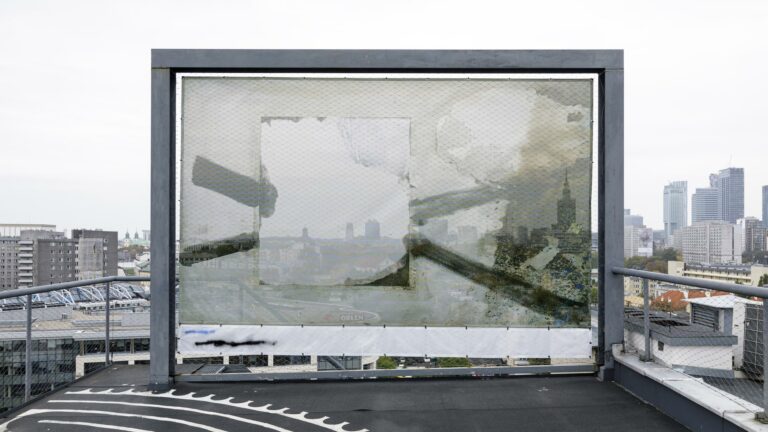Artist: Mikołaj Moskal
Exhibition title: Bones
Curated by: Jagna Lewandowska
Venue: SABOT, Cluj-Napoca, Romania (a collaboration with Wschód gallery, Warsaw)
Date: June 8 – July 28, 2017
Photography: YAP Studio, all images copyright and courtesy of the artist and SABOT
After the Persian wars in ancient Greece, the Delphic oracle commanded the Athenians to gather Theseus’s* bones and bring them back to Athens. Cimon, an Athenian statesman and general, agreed to accept the mission. After long searches, he noticed an eagle digging the ground and took it as a sign. In this very spot, a giant skeleton worthy of a demigod was excavated. The bones were transported to Athens where they were buried with honors in the middle of the city, and a colossal mausoleum was erected at the burial site to honor the mythical hero. From the descriptions, it has been discerned that the bones buried in 474 A.C.N. belonged to an already extinct animal species; like the bones of a prehistoric whale, which were once worshiped in one of the Polish churches as relics of Adam and Eve.
Bones, especially when you come across them suddenly, are always accompanied by mixed emotions. Bones arouse the imagination. Bird skeletons ripped from the hands of the children who found them adorning their yards or playgrounds, tibias of unknown backgrounds frightening people on forest trails, skull chapels and other ossuaries, wherein humans bones often serve as the building blocks of absurd installations. Bones are a specter of death and eternity; their intricate design is only unveiled when the life once surrounding them dissipates. When torn from the body they belonged to as well as from their specific functions, they become a crude reminder of nature, a trace, a clue, and finally, an object.
Mikołaj Moskal, an archaeologist à rebours, only starts to work on bones when he is not certain whether they still are, in fact, bones. For, in his imagination, the bone is already a shape, abstractly isolated from an unidentified whole, which he beholds. A fragment, which, as if by the photographic effect of zooming, has been separated from the overall composition, transferred to another frame, and suspended in the air.
The paintings of Moskal, though conceived in two dimensions, represent the image of a spatial solid. There is air, but in the form of a gray background, which is cut by a black shape with irregular edges – sometimes as delicate as a fishbone, sometimes as massive as a tibia. Sometimes the sculptural form is drawn to us in its entirety; other times, it extends beyond the paper format and there, already invisible, imagined, continues to unfold. The artist rarely makes full scale sculptures – because then, the solid would be tangible, designed, concrete. It is something else when the shape is first recorded in the artist’s memory, and then rendered in a painting impression – although it is spatial by design and originally rooted somewhere in reality, it is not obvious and burdened only by an emotional load – that is its proper ballast.
It is possible to understand the fact that order of form and order of emotion coexist in a synesthetic arrangement in the work of Moskal if one simply listens to the way the artist talks about the shapes he finds, the words he uses. For Mikołaj, encountering a moving figure, a contour – whether in nature or on a Persian carpet – is equivalent to any other emotion as an impulse for creative activity. It is just as significant for him to grasp the mood, to “portray the tension” resulting from the arrangement of the forms, or becoming the pretext for their existence. The series “Bones” is a transitional chapter, a testament to certain redefinitions. The color palette is limited in this series of works; it fluctuates between shades of black, gray and looming in some places, splashes of deep ultramarine. The shapes, thus far harmonious, subjected to careful knife cuts, start becoming complicated – jagged, curved – to finally surrender completely to the painting matter, to melt and topple the menacing cascade. There is more subtlety here, a visible game between light and shadow.
A world between the high and low tide, between glaciation and thawing. Suspended in anticipation of something new, but at the same time subjected to the exterior laws of nature (something is bound to happen). Moskal made use of this very anticipation. He did not put away the tools, but rather exploited them to dig into creative deposits and layers, eventually uncovering the bone.
*hero who died on the island of Skiros.
-Jagna Lewandowska
Mikołaj Moskal (1985) creates drawings and sculptures. He graduated from the Graphic Arts department (drawing studio diploma) of the Academy of Fine Arts in Krakow and studied at Hochschule fur Gestaltung Offenbach am Main. He lives and works in Cracow, Poland. He has exhibited in many private galleries and institutions, among which: Galerie TIC, Brno; Starter Gallery, Warsaw; BWA Design, Wroclaw; Labirynt Gallery, Lublin; Dom Umenia, Bratislava; Museum of Modern Art, Warsaw; Bunkier Sztuki, Cracow.
Warsaw-based gallery “Wschód” focuses on working with both local and international artists, public cultural institutions and project spaces worldwide. The collaboration with SABOT is part of its international program of ‘guest curatorial projects’ taking place in chosen locations across Europe. The program is designed as an up-to-a-month artist residency which concludes with a coherent project created under the curatorial guidance of the hosting institution.



































